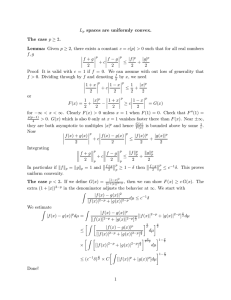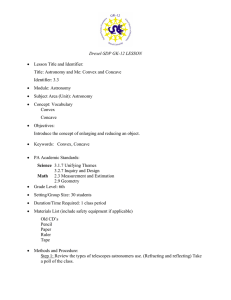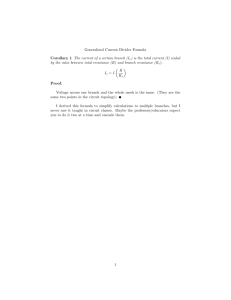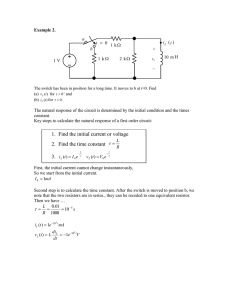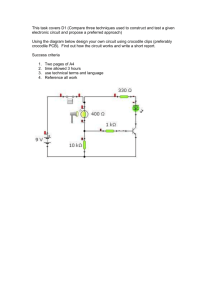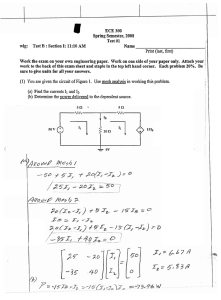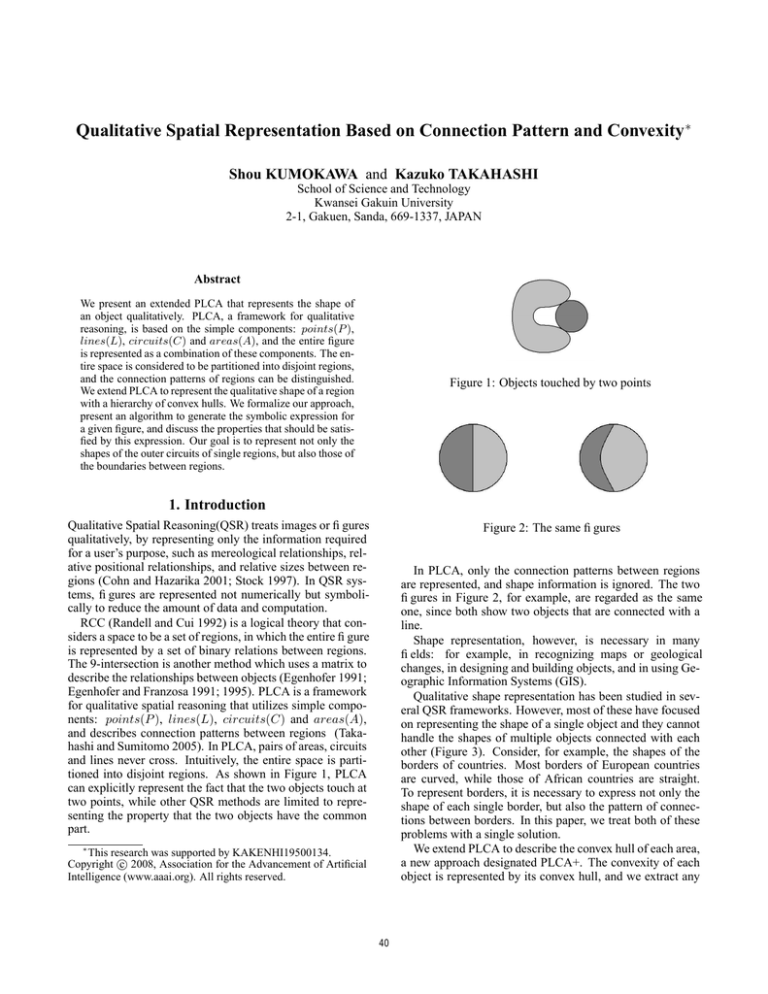
Qualitative Spatial Representation Based on Connection Pattern and Convexity ∗
Shou KUMOKAWA and Kazuko TAKAHASHI
School of Science and Technology
Kwansei Gakuin University
2-1, Gakuen, Sanda, 669-1337, JAPAN
Abstract
We present an extended PLCA that represents the shape of
an object qualitatively. PLCA, a framework for qualitative
reasoning, is based on the simple components: points(P ),
lines(L), circuits(C) and areas(A), and the entire figure
is represented as a combination of these components. The entire space is considered to be partitioned into disjoint regions,
and the connection patterns of regions can be distinguished.
We extend PLCA to represent the qualitative shape of a region
with a hierarchy of convex hulls. We formalize our approach,
present an algorithm to generate the symbolic expression for
a given figure, and discuss the properties that should be satisfied by this expression. Our goal is to represent not only the
shapes of the outer circuits of single regions, but also those of
the boundaries between regions.
Figure 1: Objects touched by two points
1. Introduction
Qualitative Spatial Reasoning(QSR) treats images or figures
qualitatively, by representing only the information required
for a user’s purpose, such as mereological relationships, relative positional relationships, and relative sizes between regions (Cohn and Hazarika 2001; Stock 1997). In QSR systems, figures are represented not numerically but symbolically to reduce the amount of data and computation.
RCC (Randell and Cui 1992) is a logical theory that considers a space to be a set of regions, in which the entire figure
is represented by a set of binary relations between regions.
The 9-intersection is another method which uses a matrix to
describe the relationships between objects (Egenhofer 1991;
Egenhofer and Franzosa 1991; 1995). PLCA is a framework
for qualitative spatial reasoning that utilizes simple components: points(P ), lines(L), circuits(C) and areas(A),
and describes connection patterns between regions (Takahashi and Sumitomo 2005). In PLCA, pairs of areas, circuits
and lines never cross. Intuitively, the entire space is partitioned into disjoint regions. As shown in Figure 1, PLCA
can explicitly represent the fact that the two objects touch at
two points, while other QSR methods are limited to representing the property that the two objects have the common
part.
Figure 2: The same figures
In PLCA, only the connection patterns between regions
are represented, and shape information is ignored. The two
figures in Figure 2, for example, are regarded as the same
one, since both show two objects that are connected with a
line.
Shape representation, however, is necessary in many
fields: for example, in recognizing maps or geological
changes, in designing and building objects, and in using Geographic Information Systems (GIS).
Qualitative shape representation has been studied in several QSR frameworks. However, most of these have focused
on representing the shape of a single object and they cannot
handle the shapes of multiple objects connected with each
other (Figure 3). Consider, for example, the shapes of the
borders of countries. Most borders of European countries
are curved, while those of African countries are straight.
To represent borders, it is necessary to express not only the
shape of each single border, but also the pattern of connections between borders. In this paper, we treat both of these
problems with a single solution.
We extend PLCA to describe the convex hull of each area,
a new approach designated PLCA+. The convexity of each
object is represented by its convex hull, and we extract any
∗
This research was supported by KAKENHI19500134.
c 2008, Association for the Advancement of Artificial
Copyright °
Intelligence (www.aaai.org). All rights reserved.
40
Figure 3: Figures including multiple objects
(a) Point and Line
(b) Circuit and Area
Figure 5: PLCA components
l1
p1
l2
Figure 4: Hierarchical representation of convexity
l3
(a)
concavity as the difference between the area and its convex
hull. We construct the convex hulls of the extracted parts
recursively. Using this approach, it is possible to express
the detailed shapes of regions (Figure 4). Our goal is to
represent not only the shape of the boundaries of a single
object, but also the detailed connection between objects and
the convexity of areas.
We present an algorithm for generating a PLCA+ expression from a given figure in a two-dimensional plane, and discuss the properties the expression satisfies. We also discuss
the expressive power of PLCA+.
This paper is organized as follows. In section 2, we
present the formal definition of PLCA+, an extended PLCA
expression, and the conditions that are to be satisfied. In section 3, we describe an algorithm for generating the symbolic
representation of a given figure in a two-dimensional plane,
and show the properties that are satisfied. In section 4, we
compare our approach with the other works, and discusses
the ability of PLCA+. Finally, in section 5, we show the
conclusion.
l1
p2
c1
p1
p2
l2 c
2
l3
c3
(b)
Figure 6: Multiple lines with the same definition and the
associated circuits
lines l1 .ps, l2 .ps and l3 .ps are defined to be [p1 , p2 ], but they
are distinguished by the circuits to which they belong.
In this paper, we assume that each line in the figure is
curved, although PLCA permits straight lines.
Circuit is defined as a class that satisfies the following
condition: for an arbitrary instance c of Circuit, c.ls is
a sequence [l1∗ , . . . , ln∗ ] where l1 , . . . , ln ∈ Line(n ≥ 1),
li .ps = [pi , pi+1 ](1 ≤ i ≤ n) and pn+1 = p1 . [l1∗ , . . . , ln∗ ]
∗
and [lj∗ , . . . , ln∗ , l1∗ , . . . , lj−1
] denote the same circuit for any
j (1 ≤ j ≤ n). In Fig. 6(b), we have three circuits:
c1 .ls = {l1− , l2+ }, c2 .ls = {l2− , l3+ }, c3 .ls = {l3− , l1+ }.
For c1 , c2 ∈ Circuit, we introduce two new predicates lc
and pc to denote that two circuits share line(s) and point(s),
respectively. lc(c1 , c2 ) is true iff there exists l ∈ Line such
that (l+ ∈ c1 .ls) ∧ (l− ∈ c2 .ls). pc(c1 , c2 ) is true iff there
exists p ∈ P oint such that (p ∈ l1 .ps) ∧ (p ∈ l2 .ps)∧
(l1∗ ∈ c1 .ls)∧(l2∗ ∈ c2 .ls). A circuit is the boundary between
an area and its adjacent areas viewed from the side of that
area.
Area is defined as a class that satisfies the following condition: for an arbitrary instance a of Area, a.cs is a set
{c1 , . . . , cn } where c1 , . . . , cn ∈ Circuit(n ≥ 1), and
∀ci , cj ∈ a.cs; (i 6= j) → (¬pc(ci , cj ) ∧ ¬lc(ci , cj )). Intuitively, an area is a connected region which consists of exactly one piece. No two areas are allowed to cross. The final
condition means that any pair of circuits that belong to the
same area cannot share a point or a line. For areas a1 and
a2 , if there exist circuits c1 and c2 such that c1 ∈ a1 .cs and
c2 ∈ a2 .cs, respectively, and lc(c1 , c2 ) holds, then a1 and
a2 are said to be line-connected.
We assume that there exists a circuit along the outermost
extremity of the figure called om(outermost). This implies
2. Definition of Extended PLCA
Definition of Classes
PLCA has four basic components: points(P ), lines(L),
circuits(C) and areas(A) (Figure 5). We add a new component subP LCA to represent the convex shape of an area.
Point is defined as a primitive class.
Line is defined as a class that satisfies the following condition: for an arbitrary instance l of Line, l.ps is a pair [p1 , p2 ]
where p1 , p2 ∈ P oint. A line has an inherent orientation.
When l.ps = [p1 , p2 ], l+ and l− mean [p1 , p2 ] and [p2 , p1 ],
∗
respectively. l∗ denotes either l+ or l− , and lre
denotes the
∗
line with direction inverse of that of l . Intuitively, a line is
the edge connecting two (not always different) points. No
two lines are allowed to cross. Note that multiple distinct
lines may be defined by the same pair of points. In Fig. 6(a),
the arrows denote the orientations of the lines. All of the
41
Figure 7: Important components of convex hull
that the target figure is finite and bounded, and the space can
be partitioned into a number of areas that do not overlap with
each other.
SubPLCA is defined as a class that satisfies several conditions, for an arbitrary instance se of SubP LCA, these are
as follows:
Figure 8: A tree structure of e+ .ses
definition 4 (the background area) se.oa is an Area a that
satisfies:
se.iom ∈ a.cs
∧ |a.cs| = 2
∧ a ∈ se.as
∧ a 6= se.area
definition 1 (SubPLCA)
se.ps = {p0 , p1 , · · · , pn−1 }
where p0 , p1 , · · · , pn−1 ∈ Point
se.ls = {l0 , l1 , · · · , ln−1 }
where l0 , l1 , · · · , ln−1 ∈ Line
se.cs = {c0 , c1 , · · · , cn−1 }
where c0 , c1 , · · · , cn−1 ∈ Circuit
se.as = {a0 , a1 , · · · , an−1 }
where a0 , a1 , · · · , an−1 ∈ Area
se.area = a
where a ∈ se.as
se.som = c
where c ∈ se.cs
It means that the only circuits belonging to the background area are the inner circuit of the frame and the outer
circuit of the convex hull of the extracted area.
Tree Structure of SubPLCAs If the source figure contains n areas, then n SubPLCAs se0 s are defined independently. Moreover, if a concave part of the source figure
has concave sub-parts, we use hierarchical representation
to capture its shape. Each SubPLCA is a PLCA+ expression that includes SubPLCA recursively. As a result, for
a PLCA+ expression e+ , e+ .ses has a tree structure (Figure 8). For a SubPLCA se, if se.area = a ∧ se.as =
{a, a1 , a2 , · · · , an }, Area a is said to be a parent Area of
Area a1 , a2 , · · · , an , and a1 , a2 , · · · , an are said to be child
Areas of Area a.
We call this expression SubPLCA of Area a.
Intuitively, SubPLCA se represents a restricted frame in
which the extracted area se.area from the source figure is
pasted. There exists a circuit along the outermost extremity
of the frame called som(suboutermost).
We also define three components of se. se.iom is the
inner circuit of the frame, se.oca is the outer circuit of the
convex hull of the extracted area, and se.oa, which is called
the background area, is the area between the convex hull
of the extracted area and the outer boundary of the frame.
These components are illustrated for a particular figure in
Figure 7, and their formal definitions are given below.
PLCA+ Expression
PLCA+ expression is defined as a class that satisfies the following condition: for an arbitrary instance e+ of PLCA+
expression, e+ .ps, e+ .ls, e+ .cs, e+ .as and e+ .ses are sets
of Points, Lines, Circuits, Areas and subPLCA expressions,
respectively, and e+ .om ∈ e+ .cs is the outermost circuit of
the whole figure.
definition 2 (the inner circuit of the frame) se.iom is a Circuit c that satisfies:
definition 5 (element) (i) Let p, l, c and a be Point, Line,
Circuit and Area, respectively. If p ∈ l.ps, then p is said to
be an element of l. If l ∈ c.ls, then l is said to be an element
of c. If c ∈ a.ls, then c is said to be an element of a. (ii) Let
o1 , o2 and o3 be each a Point, Line, Circuit or Area. If o1
is an element of o2 and o2 is an element of o3 , then o1 is an
element of o3 .
∗
∀l∗ ∈ se.som.ls(lre
∈ c.ls)
∗
∈ se.som.ls)
∧ ∀l∗ ∈ c.ls(lre
∧ c ∈ se.cs
It means that for each line l ∗ that belongs to the suboutermost circuit, the line oriented opposite to l ∗ belongs
to se.iom, and vice versa.
definition 3 (the outer circuit of the convex hull of the extracted area) se.oca is a Circuit c that satisfies:
Consistency of PLCA+
definition 6 (consistency) A PLCA+ expression e+ is said
to be consistent iff the following constraints are satisfied.
c ∈ se.oa.cs ∧ c 6= se.iom
42
Figure 9: A figure corresponding to a SubPLCA that does
not satisfy the uniqueness of se.iom
Figure 11: A figure corresponding to a SubPLCA that
does not satisfy the line-connectedness between se.area and
se.oa
Figure 12: Inner Circuit and Outer Circuit
Figure 10: A figure corresponding to a SubPLCA that does
not satisfy the uniqueness of se.oa
|e+ .ps| − |e+ .ls| − |e+ .cs| + 2|e+ .as| = 0
¡
∀se ∈ e+ .ses
¢
|se.ps| − |se.ls| − |se.cs| + 2|se.as| = 0
Constraint on Point-Line Each Point belongs to some
line. Each Point in l.ps should belong to e+ .ps where l belongs to e+ .ls. For each SubPLCA, the same constraints
hold.
Constraint on Line-Circuit Each Line belongs to exactly
two distinct Circuits. Each Line in c.ls should belong to
e+ .ls where c belongs to e+ .cs. For each SubPLCA, the
same constraints hold.
Constraint on Circuit-Area Each Circuit besides
outermost and suboutermost belongs to exactly one Area.
Each Circuit in a.cs should belong to e+ .cs where a belongs
to e+ .as. For each SubPLCA, the same constraints hold.
Due to these three constraints, neither isolated lines nor
points are allowed.
Constraint on SubPLCA There exist a unique se.area,
se.som, se.iom, se.oca and se.oa for each subPLCA.
Moreover, the extracted area se.area and the background
area se.oa should be line-connected.
The uniqueness of se.iom eliminates the case shown in
Figure 9. The uniqueness of se.oa eliminates the case shown
in Figure 10. The line-connectedness of se.area and se.oa
eliminates the case shown in Figure 11.
We require additional planarity constraints between Area
and SubPLCA, and between SubPLCAs.
Inner and Outer Before presenting the additional planarity conditions, we introduce concepts of Inner and Outer.
First, we define the predicates ioc(is Outer Circuit) and
iic(is Inner Circuit) for a Circuit c as follows.
definition 7 (Inner/Outer Circuit)
c = e+ .om
∃se ∈ e+ .ses(c = se.som)
¡∗
¢
0
true
∀l∗ ∈ c.ls lre
∈ c0 .ls
∧
¬ioc(c
)
³
ioc(c) =
∀a ∈ {a|c ∈ a.cs}
¡
¢´
∃c0 ∈ a.cs \ {c} ¬ioc(c0 )
f alse otherwise
½
true
¬ioc(c)
iic(c) =
f alse otherwise
Intuitively, an Outer Circuit is a Circuit that describes the
outer boundary of an Area, while an Inner Circuit describes
the inner boundary (Figure 12). For a consistent PLCA expression, it is decidable whether a Circuit is an Inner Circuit
or an Outer Circuit (Takahashi and Sumitomo 2008).
Next, we define the predicate io(Inner Object) for components o1 and o2 as follows.
Planarity of PLCA+
We investigated the planarity condition for PLCA expressions (Takahashi and Sumitomo 2008). For a PLCA+ expression, since e+ and each SubPLCA se are also regarded
as PLCA expressions, they satisfy the planarity condition:
43
Figure 14: Convexity of Line and constraints on SubPLCAs
Figure 13: Inner Objects in an Area
definition 8 (Inner Object)
o1 ∈ As ∧ o2 ∈ o1 .cs
o1 ∈ Cs ∧ o2 ∈ o1 .ls
o1 ∈ Ls ∧ o2 ∈ o1 .ps
iic(o1 ) ∧ o1 ∈ o2 .cs
io(o1 , o2 ) =
∗
ioc(o1 ) ∧ l ∈ o1 .ls
∗
∧∃c ∈ o2 .cs(lre
∈ c.ls)
io(o1 , o3 ) ∧ io(o3 , o2 )
Figure 15: Inside of Area a
Let o1 and o2 each be a Point, Line, Circuit or Area. Intuitively, io(o1 , o2 ) is true if o2 is contained within o1 , and
f alse, otherwise (Figure 13).
areas are line-connected, one is convex and the other is concave.
Constraint on Area-SubPLCA For each Area a other
than the background area in an se, there exists an Area in
some se0 the parent Area of which is a. Background areas
have no children. These constraints are formalized as follows.
S
Let Asse.oa = se∈e+ .ses se.oa.
³¯
´
¯
∀a ∈ As \ Asse.oa ¯{se|se.area = a}¯ = 1
¯
¯
¯{se|a ∈ se.as}¯ = 1
S
/ se∈e+ .ses se.area
∀a ∈ Asse.oa ∧a ∈
∧a ∈
/ e+ .as
∗
∀l∗ ∈ se1 .oca.ls(lre
∈
/ se2 .oca.ls)
+
(se1 , se2 ∈ e .ses ∧ se1 6= se2 )
3. Generation of PLCA+
Constructing PLCA+ from PLCA and Figure
For a given figure F in a two-dimensional plane, we have already described the construction of a PLCA expression e for
F (Takahashi and Sumitomo 2008). Here, we describe the
generation of a PLCA+ expression e+ from F and e. Note
that A and A0 denote the parts in the figure F corresponding to the expression a and the convex hull of A. In this
algorithm, for each area in F , we build a surrounding frame
for that area’s SubPLCA, construct expressions corresponding to the inside of A and to the background in the frame,
and combine these expressions. If the extracted area has a
concave part, this process is repeated recursively.
Here, we present the outline of the algorithm.
Initially, e+ .ps, e+ .ls, e+ .cs, e+ .as are set to be {}.
function : generate(F, e)
(a) Set e+ .ps = e+ .ps ∪ e.ps, e+ .ls = e+ .ls ∪ e.ls,
e+ .cs = e+ .cps ∪ e.cs and e+ .as = e+ .as ∪ e.as.
(b) Set e+ .ses = {} and Areas = e+ .as.
(c) Repeat (d) until Areas = {}.
(d) Select an arbitrary Area a from Areas, and proceed
the followings.
(d1) The inside of the Area Each element of a is
added to se.ps, se.ls, se.cs and se.as, depending on
its class. In addition, set se.area = a (Figure 15).
(d2) The outside of the Area Make a SubPLCA expression se which consists of the only one area a0 containing one Point, one Line, and two Circuits se.som
and se.iom (Figure 16).
An Area a and all of its Inner Objects are included in the
interior of the background area of the SubPLCA of a. This
constraint is formalized as follows.
se.area = a
½ ¯ ¡
¾
¢
¯ io(a, p) ∧ p ∈ P s
se.ps ⊇ p ¯¯
∨∃l ∈ {l|l∗ ∈ se.som.ls}(p ∈ l.ps)
n ¯¡
o
¢
¯
se.ls ⊇ l¯ io(a, l) ∧ l ∈ Ls ∨ l∗ ∈ se.som.ls
¯
¯
io(a, c) ∧ c ∈ Cs
¯
¯ ∨ c = se.som
se.cs ⊇ c ¯
¯¯ ∨ c = se.iom
∨ c = se.oca
( ¯
)
¯
io(a, a0 ) ∧ a0 ∈ As
¯
se.as ⊇ a0 ¯ ∨ c = se.oa
¯ ∨ c = se.area
Constraint on SubPLCA-SubPLCA Consider the SubPLCAs of areas that are line-connected. The line shared by
these areas should not connect to the background areas of
the SubPLCAs (Figure 14). This reflects the fact that when
44
Figure 16: The background in the frame
Figure 19: Convexity of Line
The Line expression corresponding to the overlap between A and A0 when they are superimposed is said to be
convex, and that not corresponding to the overlap is said to
be concave (Figure 19). Note that the convexity of a Line is
defined with respect to the inside of A and it is inverted with
respect to the outside of A. For a directed Line l ∗ , which is
an element of an Area a, convex(l ∗ ) denotes that Line l is
convex with respect to an Area a; and concave(l ∗ ) denotes
that Line l is concave with respect to an Area a.
Each line in the figure is curved. Therefore, the Line in
se.oca is concave, since se.oca corresponds to the outer circuit of the convex hull. Hence, the following properties hold.
Figure 17: Combining
(d3) Combining expressions Make a new Circuit expression corresponding to the circuit that encircles the
outer part of Area a, and add it to both se.cs and
se.oa.cs (Figure 17).
(d4) Generating expression for concavity If the convex hull A0 is not filled by the area A in F , obtain the
concave part of A by comparing A and A0 in F . To do
this, we use the Line-division and Area-generation operators (Sumitomo and Takahashi 2007) (Figure 18).
Otherwise, do nothing.
(d5) Updating Areas Add se to e+ .ses, and add all
Areas in se.areas other than se.area and se.oa to
Areas.
∗
convex(l∗ ) ↔ concave(lre
)
³
¡
¢´
∀se ∈ e+ .ses ∀l∗ ∈ se.oca.ls concave(l∗ )
An Algorithm for Judging the Convexity of Line We
give an algorithm for determining the convexity of a Line
which is not included in the outermost or sub-outermosts.
function : getConvexity(l∗ )
Consider SubPLCA se such that l ∗ ∈ se.ls holds.
(a) If l∗ ∈ se.oca.ls, then concave(l ∗ ).
∗
(b) If l∗ ∈
/ se.oca.ls, consider getConvexity(lre
).
∗
(b1) If convex(lre ) is obtained as the result of
∗
getConvexity(lre
), then concave(l∗ ).
∗
(b2) If concave(lre ) is obtained as the result of
∗
getConvexity(lre
), then convex(l∗ ).
The convexity of each Line can be determined by this algorithm (see Appendix).
Judgment of Line Convexity
For a given PLCA+ expression, assume that a and a0 are the
expressions corresponding to the Area A and its convex hull
A0 in the figure. If A and A0 are matched, that is, A0 is fully
occupied by A, then A is said to be convex. Otherwise, it is
said to be concave.
4. Discussion
There have been several previous studies of qualitative shape
representations.
Some authors have taken a logic-based approach in which
the relationships between the regions are represented using
predicates. Gotts provided a qualitative representation of
the shape of a region in the RCC framework (Gotts 1994).
He used a predicate that signifies a connected relation and
showed that various types of qualitative shape reference can
be represented using Clark’s C operator in first-order logic.
Cohn proposed a symbolic representation for the shapes of
figures (Cohn 1995), and extended RCC to represent differences between the shapes of regions in first-order logic. In
Figure 18: Generation of concavity
45
in a two-dimensional plane by representing the connection
patterns of regions using the simple components of Point,
Line, Circuit and Area. PLCA+ can additionally represent
the convex shapes of regions. We can reason about the convexity of a single region, and the connectivity of multiple
regions with the convexity information.
We have given the properties to be satisfied by a PLCA+
expression generated from a figure, which are considered to
be necessary and sufficient conditions for the planarity of a
PLCA+ expression. In future, we will attempt to prove this
property.
Extensions of PLCA+ are also under consideration. We
would like to treat figures that use straight lines and also to
represent other relationships between regions, including the
“geometric inside.”
Figure 20: Geometric inside
Cohn’s framework, concavity of a region is defined by the
difference between the original shape of the region and its
convex hull. He represented subtle qualitative shape differences using the relative positional relationships of the concave parts of a region, and used a hierarchical representation of regions to capture complicated shapes. Although
these studies demonstrated the expressive power of RCC or
the C operator, new predicates and axioms must be defined
every time a new distinction is introduced, and there have
been no discussions of well-definedness. Pratt investigated
shape representation in an algebraic manner (Pratt 1999). In
PLCA+, we also utilize convex hulls and a hierarchical representation of complicated shapes. However, our approach
to representation is object-oriented, rather than relying on
predicates. Moreover, the above-mentioned frameworks address only the shape of a single object, and not relationships
between multiple objects. For example, the connection between two objects with concave parts shown in Figure 3 cannot be represented in these other methods, while it can be
represented in PLCA+.
Another approach to qualitative shape representation focuses on the shapes of the lines between regions. In
(Museros and Escrig 2004), each line is divided into several
segments, and properties such as the qualitative shape, angle and size of each segment are represented. This method,
requires a large amount of information even for a single segment. In (Nedas and Egenhofer 2004), each line is also
divided into segments, and the relationships between these
segments are represented. In (Schlieder 1996), the shape
of the line is represented by a positional ordering of points
on the line. In these methods, it is sometimes difficult to
choose the locations of the representational points, with potential for a large amount of redundancy. Moreover, it is
impossible to represent the locations of the objects shown
in Figure 20 called the “geometric inside” using only this
line information. Therefore, we focused on convex hulls in
PLCA+. Although PLCA+ does not currently represent a
case of “geometric inside,” it is possible with a little extension.
References
A. G. Cohn. A hierarchical representation of qualitative
shape based on connection and convexity. In Spatial Information Theory: Cognitive and Computational Foundations
of Geographic Information Science (COSIT95), SpringerVerlag, pages 311–326, 1995.
A. G. Cohn and S. M. Hazarika. Qualitative spatial representation and reasoning: an overview. Fundamental Informaticae, 46(1-1):1–29, 2001.
M. J. Egenhofer. Reasoning about Binary Topological Relations. Second Symposium on Large Spatial Databases,
pages 143–160, Springer-Verlag, 1991.
M. Egenhofer and R. Franzosa. Point-Set Topological Relations. International Journal of Geographical Information
Systems 5, 1991.
M. Egenhofer and R. Franzosa. On the equivalence of topological relations. International Journal of Geographical
Information Systems, 9(2):133–152, 1995.
N. Guarino, S. Borgo and C. Masolo. A pointless theory of
space based on strong connection and congruence. In Proceedings of the Fifth International Conference on Principles of Knowledge Representation and Reasoning (KR96),
pages 220–229. Morgan Kaufmann Publishers, 1996.
N. M. Gotts, How far can we ’C’? defining a doughnut
using connection alone. In Proceedings of the Fourth International Conference on Principles of Knowledge Representation and Reasoning (KR94), pages 246–257, Morgan
Kaufmann Publishers, 1994.
L. Museros and M .T .Escrig. A qualitative theory for shape
representation and matching. In 18th International Workshop on Qualitative Reasoning. 2004.
K. Nedas and M. Egenhofer Splitting ratios: Metric details of topological line-line relations. In Seventeenth International Florida Conference on Artificial Intelligence
(FLAIRS04), 2004.
I. Pratt. Qualitative spatial representation languages with
convexity Journal of Spatial Cognition and Computation,
1:181–204, 1999.
D. Randell, Z. Cui and A. Cohn. A spatial logic based on
regions and connection. In Proceedings of the Third In-
5. Conclusion
We have proposed a qualitative spatial representation called
PLCA+, which extends PLCA to handle qualitative shape
representation using convex hulls. We formally defined
PLCA+ and presented an algorithm to generate the PLCA+
expression for a given figure.
PLCA provides a symbolic expression to describe figures
46
ternational Conference on Principles of Knowledge Representation and Reasoning (KR92), pages 165–176. Morgan
Kaufmann Publishers, 1992.
J. Renz. Qualitative Spatial Reasoning with Topological
Information. LNAI-2293. Springer Verlag, 2002.
C. Schlieder. Qualitative shape representation. In A.
Frank(Ed.), Spatial Conceptual Models for Geographic
Objects with Undetermined Boundaries, pages 123–140.
London:Taylor & Francis, 1996.
O. Stock(ed.), editor. Spatial and Temporal Reasoning.
Kluwer Academic Press, 1997.
T. Sumitomo and K. Takahashi. The qualitative treatment
of spatial data. In International Journal on Artificial Intelligent Tools 16(4), pages 661–682, 2007.
K. Takahashi and T. Sumitomo. A framework for qualitative spatial reasoning based on the connection patterns of
regions. In IJCAI-05 Workshop on Spatial and Temporal
Reasoning, pages 57–62, 2005.
K. Takahashi, T. Sumitomo and I. Takeuti. On Embedding
a qualitative representation in a two-dimensional plane.
Spatial Cognition and Computation, to appear.
Figure 21: The SubPLCA for a leaf node
concave(l2+ ) holds since l2+ ∈ se.oca.ls. Therefore,
convex(l2− ) holds. Thus, the lemma holds.
Q.E.D.
lemma 2 Assume that the convexity of each line in all of the
SubPLCAs sei (1 ≤ i ≤ n), which are the SubPLCAs of
Areas in se.as is decidable. Then, the convexity of each line
in SubPLCA se is decidable.
Proof)
Let Lsinternal = se.ls \ {l|l∗ ∈ se.som.ls}. It is sufficient to prove that
¡
¢
∗
∀l∗ ∈ Lsinternal convex(l∗ ) ∧ concave(lre
)
Appendix. Decidability of Line Convexity
For aS
consistent planar PLCA+ expression e+ , let Lsse be
Ls \ se∈e+ .ses {l|l∗ ∈ se.som.ls}, which is equivalent to
S
∗
se∈e+ .ses se.ls \ {l|l ∈ se.som.ls}.
We show that the convexity of each Line in each SubPLCA is decidable. We prove this by induction on the tree
structure of SubPLCA given in Section 2.
Lsinternal can be divided into three subsets: the directed
Lines in se.oca, the directed Lines belonging to the Circuit
in se.area.cs, and the directed Lines belonging to the Circuit in sei .cs.
¡
¢
∀l∗ ∈ se.oca.ls concave(l∗ ) holds and the convexity of
each Line in sei is decidable from the induction hypothesis.
The shape of the Line belonging to the circuit in se.area.cs
is determined by the definition of line convexity. That is,
the convexity of every Line in Lsinternal can be obtained.
Moreover, the convexity of each Line is decidable, since
e+ is a consistent planar expression. Therefore, the lemma
holds.
Q.E.D.
lemma 1 The convexity of each Line in SubPLCA se at the
leaf node is decidable.
¡
¢
∗
∀l∗ ∈ Lsleaf node convex(l∗ ) ∧ concave(lre
) .
Proof)
In this case,
se.as = {se.oa, se.area}
holds, since the SubPLCA of se.area is equivalent to se
itself and there is no child node.
The number of other components of se is fully determined, since it is consistent and planar. Therefore, the
PLCA+ expression for se is as follows (Figure 21):
theorem 1 For a consistent planar PLCA+ expression, the
convexity of each Line in the expression is decidable.
Proof) The theorem holds from the above two lemmas.
Q.E.D.
se.ps = {p1 , p2 }
l1 .ps = [p1 , p1 ]
se.ls = {l1 , l2 }
l2 .ps = [p2 , p2 ]
se.cs = {c1 , c2 , c3 , c4 } c1 .ls = [l1+ ]
se.as = {a1 , a2 }
c2 .ls = [l1− ]
se.area = a2
c3 .ls = [l2+ ]
se.som = c1
c4 .ls = [l2− ]
se.iom = c2
a1 .cs = {c2 , c3 }
se.oa = a1
a2 .cs = {c4 }
se.oca = c3
In this case, it is sufficient to determine the convexity of
the directed Lines of l2+ and l2− .
47

